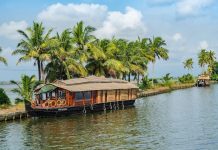
Eye-popping, right? Unfortunately, this is the sheer reality of many pristine beaches in Goa! With the distinction of being a tourist-favourite destination, Goa is fast becoming famous for its on-the-brink-of-being-seriously-damaged ecology, resulting from irresponsible tourists flocking to the state. Isn’t it high time to buckle up and save #GorgeousGoa from complete devastation? Absolutely, yes!
The Troubled Zones in Goa
Let’s check-out the red spots and look into the steps taken towards conservation.
- Aguada Fort is a popular tourist destination of Goa. And a trip to Aguada Fort, is inevitably followed by a trip to Sinquerim Bay for dolphin spotting! But did you know, that the stress of a large number of motor-boats hovering on the water is taking a toll on the popular Humpback dolphins who have been recently classified as ‘endangered’ from ‘near-threatened’? A group of boats venture out early morning to look up a pod of dolphins and after spotting them, the boats don’t let the dolphins get out of sight! They inform others about the location and tourists are brought along to see the dolphins. This intrusion hampers their mating and socializing behaviours. The government and local bodies are trying to sensitize the fishermen who ferry the tourists around about the behaviour patterns of the dolphins, but the gaps are still huge!

- South Goa is well-known for its relatively cleaner beaches and tranquil environs. Among the hidden gems, the pristine Agonda and Galgibaga beaches deserve a special mention. These beaches are the hatching sites for the Olive Ridley turtles, and sadly, without responsible tourism, we might soon have another tragic addition to the endangered species list! They are already classified as ‘vulnerable’ as of now. The turtles swim up to the beach during the breeding season, and lay about 100 eggs on a trip, which incidentally clashes with the peak season in Goa. With the exploitation of the coveted eggs by tourists, massive conservation efforts are needed. Loud music, camera flashes and any sort of construction on these beaches other than for conservation purposes have been banned. Locals have been sensitized and some even volunteer for a night watch to care for the turtles. However, the need for responsible tourism is inevitable!
- Grande Island is just a boat ride away from the Calangute-Candolim beach belt and is a popular recreational diving spot. It has been noticed how adversely irresponsible tourism is effecting the precious coral reefs here. A large amount of plastic and other garbage have often been found here – disposed of into the ocean no doubt. And, with the boats sometimes using the reefs as anchors, the vibrant corals are losing their beauty with each passing day. Though the government has implemented a lot of steps to adhere to international standards of snorkelling and diving, mostly it is up to responsible tourists to make some serious changes for visible results.
- Mangrove forests have been known as nature’s defenders and are a common sight along coastal regions of the country. Goa, being a tourist hotspot, needs mangroves more than others – to safeguard the coveted beaches and natural vistas. These mangroves are home to fascinating wildlife species as well! Although the government puts in efforts to safeguard these mangroves, irresponsible tourists damage these forests with careless disposal of garbage and contamination. Ever wondered, how our favourite beaches would look after a severe flash flood? Yes, without these mangroves, they won’t stand a chance!
What can you do as a responsible tourist in Goa?
Well, here’s a list for starters…

- Say No to Littering
Yes, please! Make it a habit to carry your own garbage until you find a designated area to dispose it off. Do not throw plastic waste in the mangrove swamps or litter the coral reefs – marine life is precious and needs to be protected.
- Say Yes to following government laws
Do not trespass on protected areas. Collect permits wherever needed and seek permission before using cameras or any other electronic devices in protected zones.
- Self-education is the key
Yes! Learn about the biodiversity of the region you’re going to visit. Have a clear idea of the specific wildlife behaviours – for example, whether camera flashes or loud noises act as triggers for certain animals. You can also reach out to responsible tourism boards, which provides information on endangered species’ behaviours.
- Say no to retail exploitation
Never be a facilitator of ecologically disturbing behaviour like stocking up on coral-made goods or curios and souvenirs made from endangered and protected species.
Soak in the flavour of Goa without barging on its fragile biodiversity. Be a new-age responsible tourist – leave just your footprints and nothing else, wherever you travel to!




